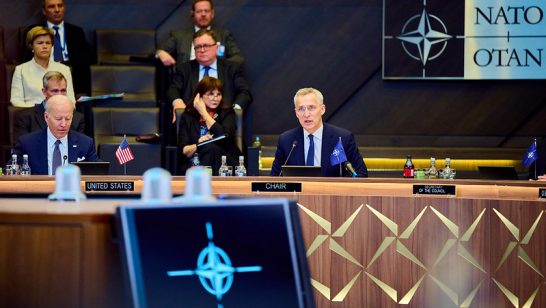
In response to the Ukraine crisis, NATO leaders decided at the Wales summit in September 2014 to implement perhaps the biggest military adaptation of the Alliance since the end of the Cold War. The main objective is a large scale strengthening and strategic adaptation of the collective defence capacities and thus a return to power of collective defence as the primus inter pares among the three core tasks agreed by the Alliance in the 2010 Strategic Concept (the two others being cooperative security and crisis management).
While this adaptation requires considerable political, financial and military commitments from all of the allies, Germany is at the centre of these efforts and is under pressure to deliver for four reasons. First, because Germany considerably shaped the Wales summit decision to focus on readiness and responsiveness instead of a large scale permanent build-up of forces in Eastern Europe. Second, because the allies expect Germany, as an economically powerful member and the Alliance’s biggest European financial contributor, to carry more of the burden. Third, Germany put itself under pressure to deliver when it submitted in 2013 the Framework Nation Concept to improve multinational defence cooperation. And forth, because other nations in the Alliance appear to be reluctant to take the lead on this adaptation either because they are preoccupied by other issues, like France in Africa; are generally less willing to take the lead on this effort, like the US; or are inhibited by budget constraints, like the UK.
The main instrument to steer the Alliance’s strategic adaptation is the Readiness Action Plan (RAP). Adopted at the Wales summit, the first steps towards implementation were agreed at the NATO defence ministers meeting in February 2015. The RAP is composed of two work strands: short term reassurance and long term adaptation measures.
In terms of reassurance, the Alliance will continue with the measures adopted in spring 2014, after the onset of the Ukraine crisis. These measures seek to reassure the Eastern allies who feel particularly exposed to Russian threats. They include increasing the frequency of air policing, AWACS flights, maritime surveillance and exercises.
In terms of adaptation, the Alliance seeks to improve its responsiveness and its readiness. This means that NATO has to re-learn to move and command large scale units quicker; be it to the east or the south flank of the Alliance. Essentially, NATO has to re-learn collective defence. Creating the necessary conditions for a revamped collective defence in terms of logistics, equipment, planning and exercises requires a profound change to what the Alliance has been doing over the last decade. Preoccupied by crises in faraway countries, the Alliance geared its strategic thinking as well as its equipment and training to the requirement of crisis management. While Afghanistan meant strategic distance but rarely more than battalion size engagements, i.e. some 500-1,000 soldiers, the challenge is now to deploy several divisions within Europe, each with about 20,000 soldiers, plus equipment. Yet, it is more than this. Strategic thinking, equipment and training have to adapt to the fact that now NATO has to do both collective defence and crisis management.
Berlin’s role is pivotal, particularly in the task of adaptation. Germany has taken the lead in the set-up of the new Very High Readiness Joint Task Force (VJTF) or Spearhead Force in 2015. The German-Netherlands Corps is in charge of developing and testing the concepts and even beyond the conceptual input, Germany is providing considerable material contributions, such as the majority of the troops of the 2015 VJTF, the HQ, paratroopers, transportation, and infantry. This rapidly deployable force of about 5,000 troops will be part of an improved NATO Response Force (NRF), with some elements of it deployable within 2 to 3 days.
Moreover, along with Poland and Denmark, Germany has increased its personnel in the HQ of the Multinational Corps Northeast in Szczecin and also sent additional personnel to NATO to enhance defence planning. The Szczecin HQ will become the command backbone in the East. It will lead the Alliance’s new High Readiness force, and will be in charge of Article V operations in the region. Smaller regional units will give the Alliance a permanent stance in the Eastern countries.
At first glance these contributions might seem small and fragmented. Yet, putting these together and adding Germany’s standing contribution of 6-8 brigades to the NATO posture means that Germany role is critical for the successful implementation of the RAP, and of the strategic adaptation agreed in Wales.
However, this pivotal role has a price. In political terms, Germany has to persuade its public who are traditionally averse to military activities that defence matters again. Both the government and the parliament also need to be ready to decide quickly about potential multinational collective defence operations. In military terms, Germany needs to adapt its armed forces, which are still trained and equipped mainly for crisis management, to the current requirements – be it in terms of personnel, equipment and exercises. This might take time and, in financial terms, will most probably require more money.
Yet Germany benefits tremendously from its important contribution by gaining political room for manoeuvre within the Alliance. At the Wales summit, Germany objected to alternative reassurance and adaption measures, such as the permanent stationing of combat troops in the East which allies such as Poland advocated for, or abrogating the NATO-Russia Founding Act. Neither of these were agreed. By taking the lead on the RAP and the strategic adaptation Germany can also promote its ideas for dialogue with Russia with better chance of success: for its allegiance and credibility within the Alliance are beyond doubt.
The opinions articulated above represent the views of the author(s), and do not necessarily reflect the position of the European Leadership Network or any of its members. The ELN’s aim is to encourage debates that will help develop Europe’s capacity to address the pressing foreign, defence, and security challenges of our time.



